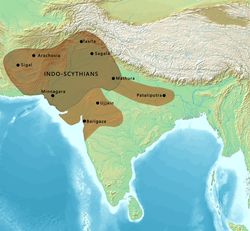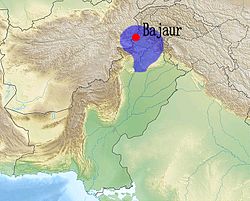The Indo-Scythians or Indo-Sakas were the branch of Saka empire in South Asia. Indo-Scythians were a group of nomadic Iranian peoples of Scythian origin who migrated from Central Asia southward into the northwestern Indian subcontinent. They started expansion in South Asia from 200 to 100 BCE and established rule between 100 and 80 BCE, their rule in Indian subcontinent was lasted until 415s CE. [1]
Contents
- List of dynasties and rulers
- Satraps dynasty of Gandhara (c. 85 BCE – 50 CE)
- Northern Satraps dynasty (c. 60 BCE – 130 CE)
- Apracha dynasty (c. 15 BCE – 50 CE)
- Western Satraps dynasty (c. 50 BCE – 415 CE)
- Minor local rulers
- See also
- References

The first Saka king of India was Maues/Moga (1st century BCE) who established Saka power in Gandhara. The Indo-Scythians extended their supremacy over north-western subcontinent, conquering the Indo-Greeks and other local kingdoms. [2] The Indo-Scythians were apparently subjugated by the Kushan Empire, by either Kujula Kadphises or Kanishka. Yet the Saka continued to govern as satrapies, forming the Northern Satraps and Western Satraps. The power of the Saka rulers started to decline in the 2nd century CE after the Indo-Scythians were defeated by the Satavahana emperor Gautamiputra Satakarni. [3] [4] Indo-Scythian rule in the northwestern subcontinent ceased when the last Western Satrap Rudrasimha IIII was defeated by the Gupta emperor Chandragupta II in 395 CE. Later Western Saka rulers (c. 396 to 415 CE) were conquered by Imperial Gupta Empire and it brings to end of Saka rule in Indian subcontinent. [5] [6]








